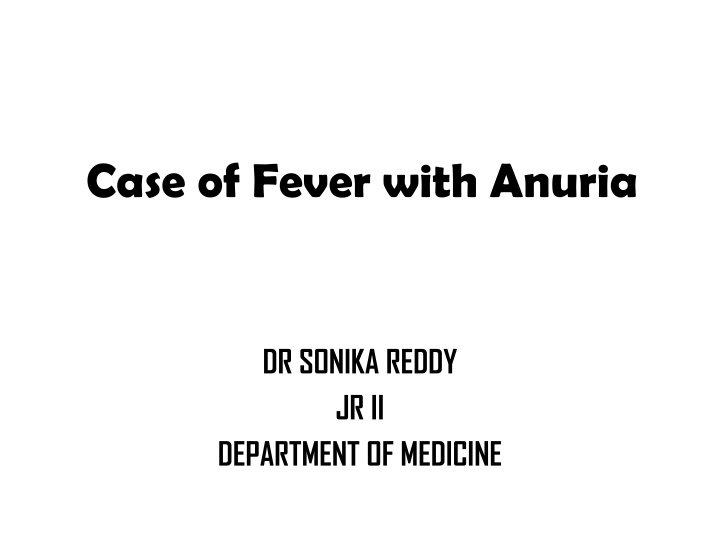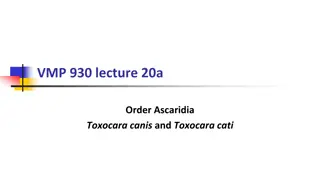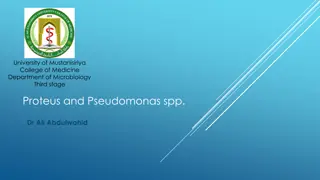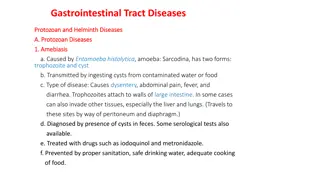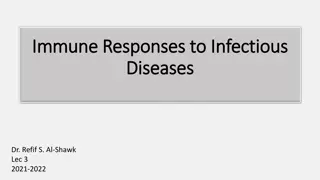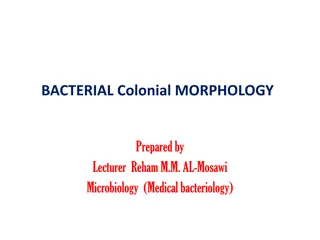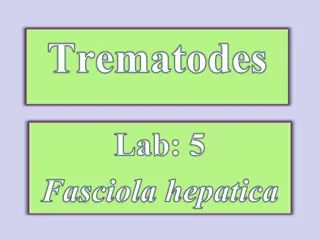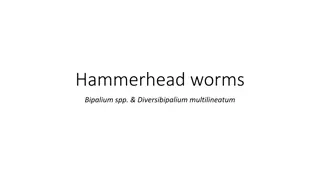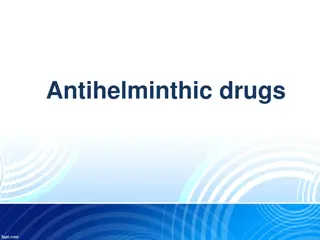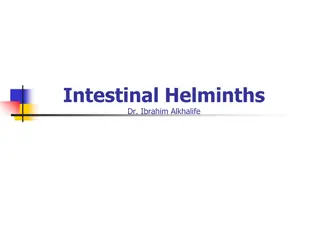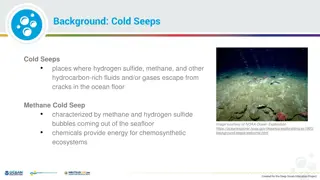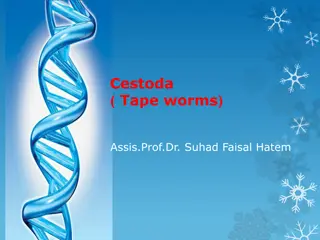Overview of Helminths (Trematoda) - Parasitic Worms and Their Morphology
Helminths, specifically Trematoda, are parasitic worms that belong to the phylum Platyhelminths and Nematoda. This encompasses liver flukes, like Fasciola hepatica, which can infect mammals including humans. The morphology and anatomy of Fasciola hepatica are detailed, showcasing its leaf-shaped body and inhabitation in the liver. Understanding the pathology of acute fascioliasis sheds light on the severe consequences of such infections, including liver inflammation and potential fatality. Images and illustrations supplement the discussion on these parasitic organisms and their impact on health.
Download Presentation

Please find below an Image/Link to download the presentation.
The content on the website is provided AS IS for your information and personal use only. It may not be sold, licensed, or shared on other websites without obtaining consent from the author.If you encounter any issues during the download, it is possible that the publisher has removed the file from their server.
You are allowed to download the files provided on this website for personal or commercial use, subject to the condition that they are used lawfully. All files are the property of their respective owners.
The content on the website is provided AS IS for your information and personal use only. It may not be sold, licensed, or shared on other websites without obtaining consent from the author.
E N D
Presentation Transcript
Case of Fever with Anuria DR SONIKA REDDY JR II DEPARTMENT OF MEDICINE
History of Present illness 28 year old male, resident of Nigdi, Pune, cloth merchant by occupation, admitted with Fever- Continuous, high grade Loose stools - 10 to 12/day, watery , foul smelling, no mucous/blood Abdominal pain diffuse, intermittent, spasmodic, non radiating Vomiting 5 to 6 times, bilious Decreased urine output Irrelevant talk, intermittently 1day. 12 days 2 days
Prior to admission, Patient received a 3 day antibiotic course from a local doctor (Tab cefuroxime 500 BD) No h/o alcohol / drug abuse No significant past and family history Clinical Examination: On admission - Conscious , was talking irrelevant intermittently - Febrile, Temp - 102 F (axilla) - Pulse 110/min, regular - BP 120/80 mm Hg, right arm supine position - RR 26/min - SpO2- 96% on room air No Pallor, icterus, cyanosis, clubbing, lymphadenopathy, edema, rash, petechiae, ecchymosis
Clinical Examination Systemic Examination: o CVS : heart sounds were normal, no other significant abnormality noted. o RS : normal vesicular breath sounds heard, no added sounds. o P/A : hepatosplenomegaly. Liver span- 17 cms, tenderness over Right Hypochondrium and Umbilical region.
Clinical Examination: o CNS: Higher Mental functions: conscious, oriented to time, place and person; but had episodes of irrelevant talk intermittently. Other higher functions were normal No other neurological deficit. Fundus -(LE) macular edema (RE) normal
Lab Investigations on the day of admission Bl.Urea 76 HB gm% 16.0 Sr.Creat 4.1 TLC /mm3 3000 Sr.Calcium 8.5 Platelet count /mm3 60,000 Sr.Uric acid 9.9 T.BIL 1.74 Sr.Phosphorus 3.3 D.BIL 0.99 Sr.Magnesium 1.67 ALT 88 Sr.Na 143 AST 158 Sr.K 4.8 ALP 113 Sr. Amylase 165 PT INR 1.0 Sr. Lipase 105 Sr.LDH 1332
Lab Investigations: Urine R/M Albumin 1+ Sugar Trace Pus cells 1-2 / hpf Epi cells 2-3/ hpf No RBC casts UPCR- 1.1 Stool R/M: Ova / cysts not seen, Occult blood positive, no pus cells.
Lab Investigations Widal slide test S.Typhi O S.Typhi H S.Paratyphi AH S.Paratyphi BH negative Dengue IgG, IgM, NS1Ag negative Rapid Malaria (Ag)Test Negative HIV, HBsAg and Anti HCV negative
Lab Investigations: CRP positive Trop T negative CPKMB 70 IU/L (0- 24 IU/L) CPK Total 240 U/L (34-145 U/L) Serum Procalcitonin 68.8 (<0.3ng/ml) Plasma fibrinogen 265.0 mg/dl (180-350) Brucella, Leptospira & Weil Felix test- Negative. Complement 3 66.5 (90- 180 mg/dl) Complement 4 23.0 (10- 40 mg/dl) Sr. ANA 2.6 U/ml (0- 10U/ml) TFT: within normal limits
Peripheral blood smear Normocytic Normochromic RBCs. Burr cells ++. Occasional schistocytes seen. No hemoparasites seen
Radiological Investigations: USG abdomen and pelvis Liver 16.4cm Spleen 15 cm Rt kidney Lt kidney Size 14 x 6.8 mm 14 x 7 mm C.M.Difference Accentuated Accentuated 2D Echo Mild global hypokinesia Left Ventricular Ejection Fraction : 45-50%
12 hours after admission He was febrile, in delirium and aggressive. Disoriented to time, place and person. Speech was irrelevant, muttering. No focal neurological deficit. Urine output was 10ml over 12 hrs. Blood pressure was maintained.
ECG ECG showed ST elevation with convexity upwards and T wave inversion along with 2D echo evidence of mild global hypokinesia with low left ventricular ejection fraction, and raised cardiac enzymes were suggestive of myocarditits.
Our Differential Diagnosis on the day of admission Gram negative sepsis due to E.coli or Salmonella species. Connective tissue disorder with sepsis Leptospirosis with Acute kidney injury, Encephalopathy, Myocarditis, Pancreatitis and Hepatitis.
Lab Investigations DAY 2 DAY 4 DAY 8 DAY 10 DAY 14 DAY 20 10.2 Hb g% 13.6 12.8 8.6 7.4 8.4 TLC/mm3 10800 3,600 5,400 12,800 15,800 11,200 Platelet/mm3 4.20 lac 80,000 50,000 1.20lac 1.70 lac 4.0 lac 0.42 T. Bil 0.79 0.58 0.56 0.27 1.20 0.16 D. Bil 0.71 0.30 0.13 0.09 0.56 29 ALT 71 82 26 5 38 62 AST 206 244 53 31 152 83 ALP 95 107 63 28 165 1 PT/INR 1.4 2.54 This were his lab invest during the course in hospital. Hb was 13.6 on admission. It was decreasing, initially, he had leucopenia and then started raising, platelet count was low, LFTs showed raised AST, PT/INR was deranged, later normalised.
Lab Investigations DAY 2 DAY 5 DAY 8 DAY 10 DAY 13 DAY 20 Bl. Urea 153 163 189 99 108 80 S. Creat 8.39 8.2 4.3 3.5 3.97 1.42 S. Calcium 7.2 7.9 4.1 7.5 8.2 S. Uric Acid 12 7.7 5.7 3.1 2.8 7.8 S. Phosphorus 5.1 7.9 4.0 5.9 S. Sodium 139 154 146 148 139 150 S. Pottasium 2.7 3.7 4.5 4.6 5 4.5 S. Amylase 165 343 1678 1389 446 S. Lipase 105 172 957.6 1465 278 This slide showed RFTs were deranged for which we had kept him on daily hemodialysis, sr.ca was low, sr ph was raised, sr amylase went upto to 1678, sr lipase was went upto to 957
Lab Investigation URINE DAY 2 DAY 4 DAY 13 Albumin 1+ 2+ 2+ Sugar trace 1+ Nil Pus cells 1-2 3-4 10-14 Epithelial cells 2-3 2-3 3-4 RBC >60/hpf >50/hpf This was the slide of U/M showed albuminuria, sugar trace, pus cells was 10-14/hpf , RBCs more than 50/hpf
Lab Investigations Blood Culture Salmonella Typhi isolated and had significant colony count.(On 7th day of admission) Sensitive to imipenem, cefoxitin, ceftazidime, cefotaxime, ampicillin,chloramphenicol, amikacin, gentamicin, cotrimoxazole Nephrologist opinion was taken for the Renal biopsy but as proteinuria was less then 400mg/day, it was not considered.
Lab Investigation MRI brain was normal. Lumbar puncture was done and CSF was normal Bone marrow Aspiration: normal
Management Supportive IV fluids and inj haloperidol was given for delirium. Initially started on Inj. Ceftriaxone 1gm BD, but later Inj. Meropenem 500gm BD and Teicoplanin 200mg OD(renal dose) were started due to suspected sepsis. Received Two Packed Red Blood Cells for anaemia. He was on daily hemodialysis for 10 days and remained anuric for a week & then went into polyuric phase. His general condition improved slowly after 4 to 5 days of polyuric phase.
LAB INVESTIGATIONS ON DISCHARGE 10/04 Hg % 12.6 TLC/mm3 8000 Platelets/mm3 3.35 lac Blood urea 38 Creatinine 1.0 ALT 30 AST 43 ALP 77 Sr Sodium 140 Sr Potassium 4.5 Sr amylase 97 Sr lipase 60 Sr LDH 203
LAB INVESTIGATION ON DISCHARGE URINE 10/04 Albumin Nil Sugar Nil Pus cells 1-2 Epithelial cells 1-2 He is on regular follow-up and has no proteinuria at present.
OUR FINAL DIAGNOSIS Gram Negative Sepsis due to Salmonella typhi with Salmonella induced encephalopathy, hepatitis, myocarditis & pancreatitis. Hemolytic Uremic Syndrome with
DISCUSSION COMPLICATIONS OF TYPHOID FEVER Disseminated intravascular coagulation Hematophagocytic syndrome Pancreatitis Hepatic and splenic abscesses and granulomas Endocarditis Pericarditis, Myocarditis Hepatitis Glomerulonephritis, Pyelonephritis and Hemolytic-uremic syndrome Severe pneumonia Arthritis, Osteomyelitis Endophthalmitis Parotitis.
HEMOLYTIC UREMIC SYNDROME HUS is characterized by triad of - Microangiopathic hemolytic anemia -Thrombocytopenia - Renal insufficiency. A confirmed diagnosis of HUS should have onset within three weeks of acute diarrhea/dysentery (our patient presented within 2 weeks)
Contd.. Hemolytic Uremic Syndrome HUS due to diarrhea is caused by - Vero-toxin producing E.coli - Shiga toxin of Shigella dysentriae type-1 - Rarely Salmonella species The pathogenesis of HUS in Enteric fever is unclear, but the expression of S.typhi virulence factors and endothelial injury with oxidative & shear stresses & resultant microvascular thrombosis may be a possible explanation. Presence of leucocytosis in typhoid fever suggests a complication and should alert one to the possibility of the haemolytic-uremic syndrome.
WIDAL TEST Cases treated early with antibiotics may shows poor agglutination response & Widal test could be negative
Take home message Widal test, although frequently used is not reliable test to diagnose Enteric fever. In a patient of enteric fever if we get leukocytosis, that should also alert the complication like hemolytic uremic syndrome, which is a rare association with Salmonella typhi infectionother than intestinal perforation leading to peritonitis.
References Huang DB, DuPont HL. Problem pathogens: extra-intestinal complications of Salmonella enterica serotype Typhi infection. The Lancet infectious diseases. 2005 Jun 1;5(6):341-8 David A. pegues., Sameul I. Miller. Salmonellosis. Kasper, D. L., Fauci, A. S., Hauser, S. L., Longo, D. L. 1., Jameson, J. L., & Loscalzo, J. (2015). Harrison's principles of internal medicine (19th edition.). New York: McGraw Hill Education. Chinnasami B, Prema A. Enteric Fever Presenting as Hemolytic Uremic Syndrome. IJSR,8 Aug 2013; 2(6). George P, pawar B. A sinister presentation of typhoid fever. Indian J Nephrol 2007;17:176-7 Albaqali A, Ghuloom A, Al Arrayed A, Al Ajami A, Shome DK, Jamsheer A, et al. Hemolytic uremic syndrome in association with typhoid fever. Am J Kidney Dis2003;41:70913. Ananthanarayan and Paniker; textbook of microbiology. 2017, 10th ed, Ch 31, Pg 304. ed Reba Kanungom Universities press, Hyderabad.
